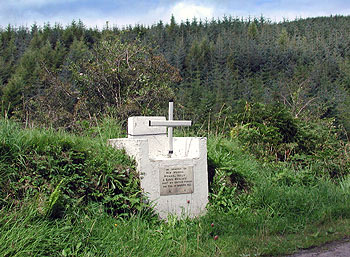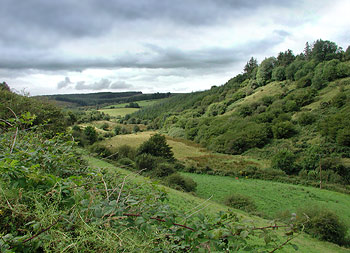|
I.R.A. Suffer Losses During Roundup at Nadd (Irish War of Independence - Second Cork Brigade)
|
|||||||||||
|
Towards the end of February, 1921
British activity in the Lombardstown area forced Liam
Lynch to move his
brigade headquarters
further west into the area then occupied by sections of the Mallow and Kanturk
Columns around Nadd. A training camp had also been in progress there for some
months, and David Herlihy's farmhouse had come to be known as "the barracks" The columns were widely dispersed amongst
the farmhouses in the district. It was a base to which columns or sections of
them returned after an action. The ambush at Father Murphy's Bridge had been
carried out by a section of the Kanturk Column, which afterwards returned to
Nadd. Here, in the driving rain and fog
of a raw March morning, the British forces staged one of their most elaborate
and well planned efforts to annihilate the brigade staff and the columns. Large
forces drawn from It was a well-planned operation,
efficiently carried out, and its limited success was attributable to factors
inherent in the conditions under which the British forces operated. For complete
success it was necessary that the raiding forces should seal off the billeting
area simultaneously on all sides, and that no alarm should be raised in the
I.R.A. camp before the various detachments surrounding it had taken up
positions. Hence the approach under cover of darkness and the detrucking of
troops well out from the target. Contact between all the component units of the
raiding force was not possible; each had to adhere to its timetable,
irrespective of what other units were doing or of whether they had in fact taken
up their position in the ring. It was precisely this aspect of the plan which
broke down, and it broke down because Liam, without any exact information of
this impending operation, had acted promptly on an intelligence report on the
previous day. Information which he received from
Judy O'Riordan in Buttevant post, indicated the
probability of large-scale raiding in the Banteer direction on the night of
9/10th. He had immediately ordered out the Charleville Battalion on a
road-cutting task at certain specified points ; this
action saved Nadd from being a major disaster. British forces from Buttevant and
Ballyvonaire were considerably delayed by trenches on the Buttevant-Mallow road,
and at Eel Weir cross, and by broken bridges at Ballyclough and Templemary. An
armoured car skidded into one trench. The result was, that when constriction of
the British ring began at dawn, one section of the north-western perimeter was
still open, some of the Buttevant and Ballyvonaire troops not having arrived.
They occupied their positions too late to prevent the escape of most of their
intended victims. Liam was billeted at Patrick
McCarthy's, a quarter of a mile north-west of Nadd cross roads. With him were
George Power and Maurice Walsh of Mitchelstown. Michael O'Connell, the Assistant
Brigade Quartermaster, had left for Lombardstown on the previous night to
arrange for the cutting of the road at Eel Weir cross. Tadhg McCarthy, Adjutant
of Mallow Battalion, was on duty in the neighbourhood of Nadd cross, with
Volunteer Walsh from Ballyclough and two local Volunteers, Dan Scanlon and Dick
Dunne. They were the first to observe troops approaching from the South.
Visibility was poor, at times bad, as the fog lifted and filled alternately.
Tadhg McCarthy and Walsh went immediately to inform Liam and the other brigade officers.
They found them already outside the house. Another report of the presence of
raiders had reached them.
The British detachment observed at
Nadd cross had turned west, evidently with the intention of approaching their
objective from the south. Liam
now had reports of the presence of troops to the north-east, south and east of
his position. Units of the columns in the scattered farm houses were alerted.
They and the brigade officers began to move westward across the mountain. At one
point a party of British troops infiltrated the position without being observed.
Before any warning had reached the house, they came to David Herlihy's. Here,
Lieutenant Edward Waters of Mallow Company, Volunteers Timothy Kiely, Joseph
Morgan and John Moloney were sleeping. Kiely was a despatch rider of
Lombards-town Company, who had come on the previous night with a despatch and
stayed. Morgan and Moloney were members of Mallow Com-pany attached to the
Mallow Battalion Column. Moloney, Kiely and Morgan were
sleeping in a room off the kitchen on the ground floor. Waters and Herlihy were
sleeping upstairs. The arms of Morgan, Moloney and Waters were in the kitchen.
The other two were not armed. A section of the Kanturk Column, under Commandant
Denis Lyons, had left " the barracks " on the previous
day to co-operate with Millstreet Battalion Column in the destruction of
They rushed in and overran the
house. They hustled the half-dressed occupants into the yard, the officer
shouting, " Get out you - we'll give you some of your
own stuff now." Covered by the rifles of the raiding party, they were taken to
the back of the house and lined up in a field. The officer, having posted his
men, said: " When I say run -." Morgan and Moloney made
a dash for liberty. Both were wounded, but managed to get away. Waters, Kiely
and Herlihy were shot dead where they stood. Bayonets were used on the
bodies. The British were now closing in.
Fire was exchanged between some detachments and groups of Volunteers. Liam himself engaged in one of these
exchanges. Garrett McAuliffe reported to him on the position in the Inchimay
direction. One Volunteer who was not on duty fell a
victim to British fire. He was Edward Twomey of Lacklown Company, a cow testing
inspector, who was at the time engaged on his civil duties. In running across a
field he was shot dead. When Morgan and Moloney escaped from the British firing
party at " the barracks " they were pursued, but by
availing of cover on the mountain they escaped. They became separated, how-ever,
Moloney getting as far as Riordan's farmhouse, Inchimay, before being picked up
by four other members of the columns who carried him on to Cahill's, Kilmacrane,
about three miles from " the barracks." Morgan fell in with Liam Lynch's party and they went on to
Jim Horgan's, Crinaloo, where Liam dressed Morgan's wound, while
Morgan gave him a report of what had happened at " the
barracks." Liam sent scouts to
locate the remaining members of the columns, and, learning that they were at
Cahill's, the whole party assembled there. Here Liam dressed Moloney's wound, and
arranged to have him sent to hospital. Dr. Ryan of Glantane attended to
him. Reports coming in gave Liam a picture of the extent of the
British operation and its results. Four Volunteers were dead, though one of them
had not been on duty, two were wounded but . not too seriously, and no one had been captured. For the
second time within a month an abnormal and disquieting feature of the British
operation impressed him. His enemies were evidently acting on accurate
information. There was a striking resemblance between what had happened at
Mourne Abbey and what had taken place at Nadd. But now the mystery was quickly
cleared up. A member of the Kanturk Column, of whom a number of the men had been
suspicious for some time, was missing. He was a man who had served in the
British Army, and who had been with the column about two
months. Subsequent inquiries established
his responsibility for the Nadd operation, and made it clear that he could also
have been responsible for the reverse at Mourne Abbey, as he was in possession
of complete information about the proposed ambush several days before it was due
to take place. Two days before the Nadd raid the ambush at Father Murphy's
Bridge had taken place and he had been ordered to parade for it, but instead of
doing so he had gone to Kanturk on the pretext of drawing his pension as a
British ex-serviceman. Later it was recalled that in his two month's service
with the column he had never taken part in an action, always having one excuse
or another for absence. In Kanturk on the 8th, he spent some time drinking, and
was later seen in the British barracks in consultation with an officer. The
local Battalion Intelligence Officer, Michael Moore, a very competent I.O.,
becoming aware of this, warned local men and sent a despatch to Brigade
Headquarters giving the information. The despatch did not reach Liam Lynch or any member of his staff, and
it is not entirely clear what became of it in the excitement created by the
raid.
|
|
|

